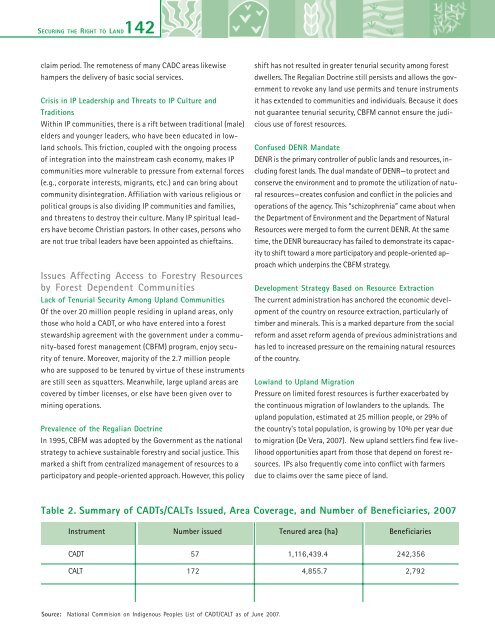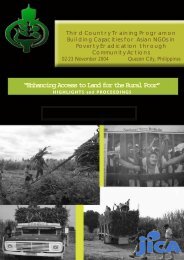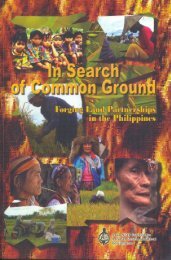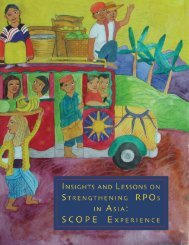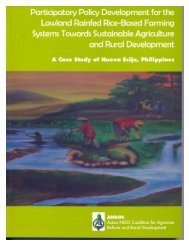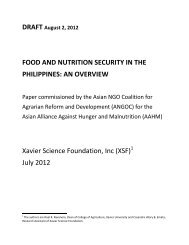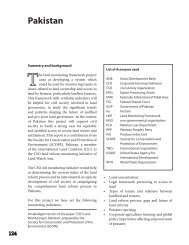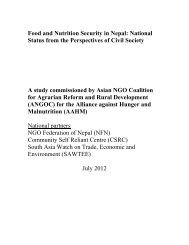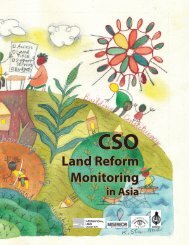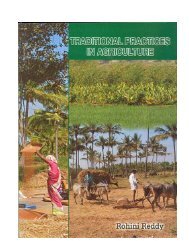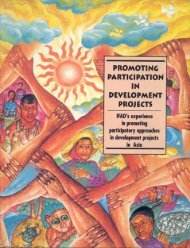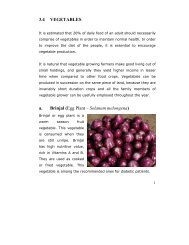Securing the Right to Land FULL - ANGOC
Securing the Right to Land FULL - ANGOC
Securing the Right to Land FULL - ANGOC
Create successful ePaper yourself
Turn your PDF publications into a flip-book with our unique Google optimized e-Paper software.
SECURING THE RIGHT TO LAND142<br />
claim period. The remoteness of many CADC areas likewise<br />
hampers <strong>the</strong> delivery of basic social services.<br />
Crisis in IP Leadership and Threats <strong>to</strong> IP Culture and<br />
Traditions<br />
Within IP communities, <strong>the</strong>re is a rift between traditional (male)<br />
elders and younger leaders, who have been educated in lowland<br />
schools. This friction, coupled with <strong>the</strong> ongoing process<br />
of integration in<strong>to</strong> <strong>the</strong> mainstream cash economy, makes IP<br />
communities more vulnerable <strong>to</strong> pressure from external forces<br />
(e.g., corporate interests, migrants, etc.) and can bring about<br />
community disintegration. Affiliation with various religious or<br />
political groups is also dividing IP communities and families,<br />
and threatens <strong>to</strong> destroy <strong>the</strong>ir culture. Many IP spiritual leaders<br />
have become Christian pas<strong>to</strong>rs. In o<strong>the</strong>r cases, persons who<br />
are not true tribal leaders have been appointed as chieftains.<br />
Issues Affecting Access <strong>to</strong> Forestry Resources<br />
by Forest Dependent Communities<br />
Lack of Tenurial Security Among Upland Communities<br />
Of <strong>the</strong> over 20 million people residing in upland areas, only<br />
those who hold a CADT, or who have entered in<strong>to</strong> a forest<br />
stewardship agreement with <strong>the</strong> government under a community-based<br />
forest management (CBFM) program, enjoy security<br />
of tenure. Moreover, majority of <strong>the</strong> 2.7 million people<br />
who are supposed <strong>to</strong> be tenured by virtue of <strong>the</strong>se instruments<br />
are still seen as squatters. Meanwhile, large upland areas are<br />
covered by timber licenses, or else have been given over <strong>to</strong><br />
mining operations.<br />
Prevalence of <strong>the</strong> Regalian Doctrine<br />
In 1995, CBFM was adopted by <strong>the</strong> Government as <strong>the</strong> national<br />
strategy <strong>to</strong> achieve sustainable forestry and social justice. This<br />
marked a shift from centralized management of resources <strong>to</strong> a<br />
participa<strong>to</strong>ry and people-oriented approach. However, this policy<br />
shift has not resulted in greater tenurial security among forest<br />
dwellers. The Regalian Doctrine still persists and allows <strong>the</strong> government<br />
<strong>to</strong> revoke any land use permits and tenure instruments<br />
it has extended <strong>to</strong> communities and individuals. Because it does<br />
not guarantee tenurial security, CBFM cannot ensure <strong>the</strong> judicious<br />
use of forest resources.<br />
Confused DENR Mandate<br />
DENR is <strong>the</strong> primary controller of public lands and resources, including<br />
forest lands. The dual mandate of DENR—<strong>to</strong> protect and<br />
conserve <strong>the</strong> environment and <strong>to</strong> promote <strong>the</strong> utilization of natural<br />
resources—creates confusion and conflict in <strong>the</strong> policies and<br />
operations of <strong>the</strong> agency. This “schizophrenia” came about when<br />
<strong>the</strong> Department of Environment and <strong>the</strong> Department of Natural<br />
Resources were merged <strong>to</strong> form <strong>the</strong> current DENR. At <strong>the</strong> same<br />
time, <strong>the</strong> DENR bureaucracy has failed <strong>to</strong> demonstrate its capacity<br />
<strong>to</strong> shift <strong>to</strong>ward a more participa<strong>to</strong>ry and people-oriented approach<br />
which underpins <strong>the</strong> CBFM strategy.<br />
Development Strategy Based on Resource Extraction<br />
The current administration has anchored <strong>the</strong> economic development<br />
of <strong>the</strong> country on resource extraction, particularly of<br />
timber and minerals. This is a marked departure from <strong>the</strong> social<br />
reform and asset reform agenda of previous administrations and<br />
has led <strong>to</strong> increased pressure on <strong>the</strong> remaining natural resources<br />
of <strong>the</strong> country.<br />
Lowland <strong>to</strong> Upland Migration<br />
Pressure on limited forest resources is fur<strong>the</strong>r exacerbated by<br />
<strong>the</strong> continuous migration of lowlanders <strong>to</strong> <strong>the</strong> uplands. The<br />
upland population, estimated at 25 million people, or 29% of<br />
<strong>the</strong> country’s <strong>to</strong>tal population, is growing by 10% per year due<br />
<strong>to</strong> migration (De Vera, 2007). New upland settlers find few livelihood<br />
opportunities apart from those that depend on forest resources.<br />
IPs also frequently come in<strong>to</strong> conflict with farmers<br />
due <strong>to</strong> claims over <strong>the</strong> same piece of land.<br />
Table 2. Summary of CADTs/CALTs Issued, Area Coverage, and Number of Beneficiaries, 2007<br />
Instrument Number issued Tenured area (ha) Beneficiaries<br />
CADT 57 1,116,439.4 242,356<br />
CALT 172 4,855.7 2,792<br />
Source: National Commision on Indigenous Peoples List of CADT/CALT as of June 2007.


